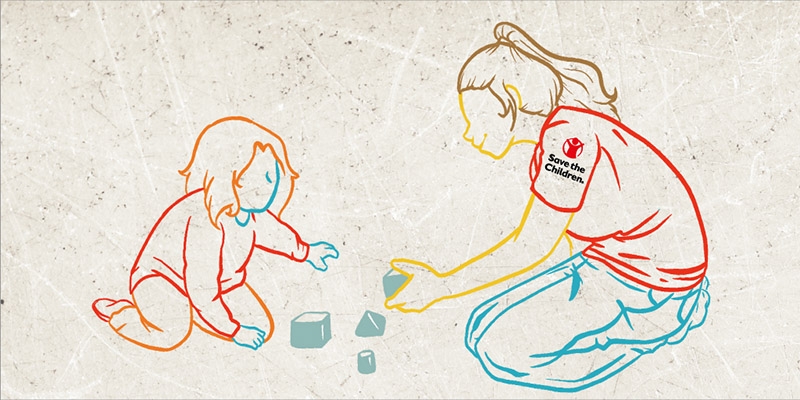
As Save the Children affirms our dedication to the Afghan people and our commitment to stay and deliver, there has never been a more important time to help.
What's It Like for Afghan Children Inside a U.S. Shelter
Written by Anne-Marie Scali, Marketing Comms & Fundraising, Save the Children
Tucked inside the cavernous arena that is now a northern Virginia transit shelter for newly-arriving Afghan families sits a space just for kids. Countless drawings have been taped up all around the carpeted area, with bright colors and hand-drawn characters on full display for weary families and shelter workers – anyone who needs a reminder of the resiliency of children.
This same kind of safe play space for kids – a place filled with coloring books and bubbles, hula-hoops and bouncy balls – could exist in any corner of the country, for any family whose child needs care. But today, it exists with the sole purpose of comforting refugee children.
Since June, tens of thousands of Afghan children have fled their homes amid escalating violence. Those who try to flee to safety can face unimaginable horrors. Many are traumatized.
For those Afghan refugees who have made it here to the U.S., many are arriving utterly exhausted, with not a single possession except for the clothes on their back. Not all families have made it out together. Some children are arriving without their siblings. Some even arrive alone.
In late August, as a Save the Children staffer deployed to northern Virginia as part of our emergency surge team, I had the privilege of welcoming some of the newly arriving refugee children - some as young as six months old.
Inside the shelter, sometimes from a distance and without a common dialogue between us, the kids and I relied on waves and smiles as introductions. Upon entering the play space, some children were hesitant to play at first, while others were immediately engaged. But when a game of “Hokey Pokey” began, no one could resist.
Toddlers clapped with delight as a scene of boys and girls putting a left leg in, left leg out unfolded again and again. By the end of the day, as more games and crafts were discovered, there wasn’t a crayon that hadn’t been flattened or a ball that hadn’t been passed through the air.
Even the process of cleaning up was an opportunity for fun. Children were eager to continue playing and more than a few helpers had emerged. Together, we collected pipe-cleaner crowns and construction paper flower bouquets. Hope had been planted here, I thought to myself.
At the entrance of the playspace lay dozens of removed shoes. Tiny pairs of sneakers and flip-flops and colorful slippers had been eagerly tossed aside as children entered the area. Looking at the collection of shoes, it was impossible not to consider the road the children and families had traveled.
In Afghanistan, where food and fuel prices have spiked, many families have become unable to afford even the most basic items. The price of bread, milk, and rice is only expected to rise further as borders close. Even access to healthcare is dwindling.
Even before the events of the last months, Afghanistan had the second-highest number of people facing emergency levels of hunger in the world. Half of all children under the age of five are expected to suffer from acute malnutrition before the year is over.
While we didn’t yet know it, the next day in Kabul, six children would be among those killed in an airstrike in the Afghan capital.
As other temporary shelters begin to open up across the country, Save the Children will continue to support Afghan refugee children and families. Our teams are right now delivering essential child-focused items, including hygiene kits, diapers, wipes, and COVID-prevention materials.
All of this is a result of our supporters, donors, and advocates. As Save the Children affirms our dedication to the Afghan people and our commitment to stay and deliver, there has never been a more important time to help.
Editor's note: Based on the needs of families', Save the Children's programming in northern Virginia has pivoted to other locations across the country, including at the border of west Texas and southern New Mexico.
Thank you for signing up! Now, you’ll be among the first to know how Save the Children is responding to the most urgent needs of children, every day and in times of crisis—and how your support can make a difference. You may opt-out at any time by clicking "unsubscribe" at the bottom of any email.
By providing my mobile phone number, I agree to receive recurring text messages from Save the Children (48188) and phone calls with opportunities to donate and ways to engage in our mission to support children around the world. Text STOP to opt-out, HELP for info. Message & data rates may apply. View our Privacy Policy at savethechildren.org/privacy.